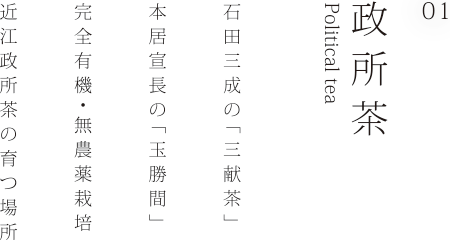
政所茶の起源
「滋賀県の御茶」といえば、朝宮茶や土山茶が有名ですが、歴史上、天下に名を轟かせた銘茶がもうひとつ存在しました。それは、鈴鹿山脈の谷あいの集落、東近江市政所町で生産される、「政所茶」と呼ばれるお茶です。いまでは“幻の銘茶”とまで言われる「政所茶」は、かつては「宇治は茶所、茶は政所」と茶摘み唄にも歌われ、幕府や朝廷にも献上されていたほどの銘茶でした。
そもそも、日本で最初にお茶の木が育てられたのが、滋賀県だったとも伝えられており、滋賀県とお茶の関わりは深いのです。そんな、滋賀県の政所の地に、お茶が初めて伝えられたのは室町時代のこと。周辺の村々は、古くから“木地師”(きじし)と呼ばれる木工職人たちの本拠地でしたが、農作物としては霜や雪害がひどいため、粟や稷などの雑穀ぐらいしか生産できなかった。そこへ、紅葉の名所として知られる臨済宗の禅寺、永源寺の越渓秀格禅師が、政所周辺はお茶の栽培に適しているとして、お茶を伝えて栽培を奨励したのが始まりなのです。
Speaking of "tea in Shiga prefecture", Asamiya tea and Tsuchiyama tea are famous, but there was another tea tea that made its name familiar in the history in history. It is a tea called "political tea" produced in Higashiomi City Municipal Town, a settlement in the valley of the Suzuka Mountains. "Politic tea" which is said to be "a visionary tea of the phantom" now is singing in tea picking songs as "Uji is a tea room, tea is a politicus" and tea picking songs that were dedicated to the shogunate and the courtroom was.
In the beginning, it is said that Shiga Prefecture was the first place to grow tea trees in Japan, and Shiga Prefecture and tea are deeply involved. Such was the first time tea was informed to the land of Shiga Prefecture's politicians about the Muromachi period. The surrounding villages were the home of woodworking craftsmen called "wooden master" for a long time, but farms and snow damage as farm crops were so terrible that they could produce only millet such as millet and cod roe. There, the Zen temple of Rinzai sect known as the landmark of autumnal leaves, Zen master Toshikoshi Koshiki of Eikenji Temple is said to be suitable for cultivating tea, encouraging cultivation by communicating tea is the beginning.
政所茶の歴史
越渓秀格禅師が想像したとおり、谷筋という地形によって生じる寒暖の差と、愛知川によって生じる朝霧が、銘茶「政所茶」を生み出しました。応仁の乱のころ、永源寺の学僧たちが京の都に「政所茶」を伝えたところ、その味わいが評判となり、その名は各地へと広まりました。戦国時代には、幼少の石田三成が秀吉に献じたとされる三杯の茶の逸話「三献茶」は、「政所茶」だったといい、風味に富んだ「政所茶」は、秀吉のお気に入りのお茶になったといわれています。
そうして江戸時代になると、徐々に生産量は増大し、遠くは東北地方にまで流通していたという記録も残っています。江戸時代の国学者「本居宣長」が著した「玉勝間」の記述もそのひとつで、「此の村人ども、夏は茶を多くつくりて、出羽の秋田へくだし、冬は炭を焼て、国内にうるとぞ。その茶をもむ時の歌、ここでもむ茶が、秋田へくだる。秋田女郎衆に、ふらりよかよ」と、当時の「政所茶」の人気ぶりが窺えるのです。そうした背景もあって、幕末から明治にかけては、「政所茶」の生産量はさらに増え、茶摘み仕事のために、毎年千人を超える茶師が、三重県側から鈴鹿山脈を越えて来た、と言われているのです。
As imagined by Koshi Hidenaka Zen, the difference between the cold and warmth caused by the valley topography and the morning mist produced by the Aichi River produced the tea "tea ceremony tea". When Jinin 's Ran, the priests of Eikenji told "the tea ceremony tea" to the city of Kyoto, its taste became a reputation, its name spread to various places. In the age of warring States, it is said that the three-cup tea anecdote 'Sansui tea', which a childhood Ishida Mitsunari contributed to Hideyoshi, was "politic tea", flavored "political tea" is Hideyoshi's favorite It is said to have become tea.
In the Edo period, there was also a record that the production volume gradually increased, and that it was distributed to the Tohoku region far away. One of the descriptions of "Tama Katsuma" written by a national scholar of the Edo period "Tama Katsuma" is "One of the villagers who made this tea in summer, we went to Akita in Aya, we burn charcoal in winter You can get to Japan, singing that tea, here too Mu tea goes to Akita, you can pretend to be a crowd of Akita girls, "the popular opinion of" political tea "at that time can be seen . Against this backdrop, from the end of the Edo period to the Meiji era, the production volume of "politic tea" further increased and more than a thousand tea masters crossed the Suzuka mountain range from Mie prefecture side every year for tea picking work It is said that.

政所茶の現在
最盛期の明治時代には、3万キロもあった製茶量も、戦時中の食糧難による芋畑への転換や、高度経済成長による生業の変化などによって、減少の一途をたどりました。さらに近年では、奥永源寺地域の高齢化率は50%に近づき、生産者の高齢化に相まって、その生産量は減少し続けています。
しかし、鈴鹿山脈の麓に暮らす人々が守り続けてきた美しい景観と、その暮らしぶりには心惹かれるものがあり、そこに惚れ込んだ人々が、他地域から奥永源寺へ移住したり、交流活動をする人が増えてきました。また政所茶に誇りをもつ地元茶農家が、荒れた茶畑の再生や茶づくり塾の開講、茶葉を使ったスイーツの開発などに挑戦するなど、新たな動きも見え始めている「今」なのです。
During the Meiji Period during the Meiji Era, the amount of tea which had been 30,000 kilometers also decreased due to the conversion to potato fields due to food shortages during wartime and the changes in birth due to high economic growth. Furthermore, in recent years, the aging rate of the Okuengenji area has approached 50%, and its production volume continues to decline due to the aging of producers.
However, there are beautiful landscapes that people who live at the foot of the Suzuka range have kept protecting, and there are things that are attracted to by their livelihoods, and those who have fallen in love there will migrate from other areas to Okunoe Genji, More and more people to do. Also, local tea farmers who are proud of the tea ceremony are "now", which is beginning to see new movements, such as challenging the regeneration of rough tea fields, the opening of tea making cram school, the development of sweets using tea leaves etc.

政所茶の特徴
政所茶の特徴は、丸みがあり肉厚なのが特徴です。また、茶樹は挿し木で増やしたものではなく、種から育てられた在来種。同じ畑の中でも一本一本の姿かたちは微妙に異なっています。この様々な個性を持つ茶葉が、政所茶独特の味わいを生み出しています。また、奥永源寺ではその地形を活かし、谷筋に沿って、急斜面に茶畑が広がっています。そのため、作業に機械を用いにくい地形であったため、今も多くの行程が手作業で行われており、収穫作業もそのすべてが手摘みで行われているのが特徴のひとつです。
さらに、奥永源寺地域で栽培されている政所茶は、化学肥料に一切頼らない、完全有機・無農薬栽培というのが特徴です。昔ながらの栽培方法を守り、植物由来の「菜種の油かす」や、「ススキやカヤ」などの有機物のみを肥料にしていて、その安全・安心な「山の香り」溢れる味わいは、政所茶一番の特徴です。
あなたも、私たちと一緒に、「政所茶のある時間と暮らし」を楽しみませんか?
Characteristic features of political tea are rounded and thick. In addition, the tea tree is not increased by cutting, it is a native species raised from seeds. Even in the same field the form of each one is subtly different. Tea leaves with this unique personality create a distinctive taste of tea ceremony. Also, in Oku Eienji Temple, utilizing its topography, tea gardens are spreading along steep slopes along valley lines. As a result, since it was a terrain that made it difficult to use the machine for work, many processes are still performed manually, and harvesting work is hand-picked all by hand.
In addition, the tea ceremony which is cultivated in Oku Eigenji temple area is characterized by complete organic / pesticide-free cultivation which does not rely on chemical fertilizer at all. By preserving traditional cultivation methods, only organic matter such as "rapeseed oil cake" or "Susuki or Kaya" is used as a fertilizer, and the safe and secure "mountain scent" overflowing taste is politic tea one It is a feature of the number.










